Memories of Yesteryear
Part 11
More women who made their mark
Gwenda Stewart
Collector of speed records and husbands!
Gwenda, born Gwenda Mary Glubb in 1894 in Preston, Lancashire, came from a family of soldiers.
Her father was Major General Sir Frederic Manley Glubb who fought in the Boer War, and her brother, John Bagot Glubb fought in WWI, becoming known as Glubb Pasha, since he commanded the Arab Legion for almost twenty years.
She drove ambulances on the Russian and Rumanian fronts in WW1 and while her wartime exploits aren't outlined in any great detail, it's known that she was awarded both the Cross of St. George and the Cross of St. Stanislav by the Romanian government.
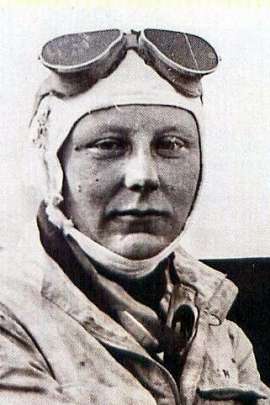
It is said that in her youth she wore her hair in a 'mannish' cut and disguised her femininity
When she returned home, Gwenda Glubb moved to Brooklands, where she married Colonel Sam Janson, the director of Spyker. Yearning for that adrenaline rush that she'd known behind the wheel, Gwenda took up motorcycle racing at the local Brooklands track and promptly fell in love.
She started her motorcycling career in the early 1920s.
In 1921, she established the 1000-mile record on a Ner-A-Car bike, covering 190 miles per day.
This strange two-wheeled American machine called a Ner-a-car had a single cylinder motor and only a rear brake. With it she completed 1000 miles in adjudicated 190 mile daily runs.
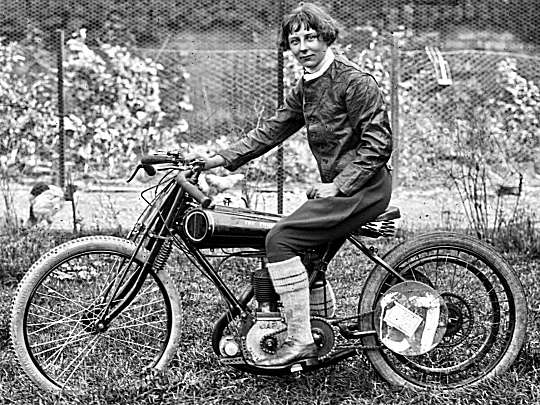
Posing on her 249 c.c. Trump-Jap which gained her the distinction of being the first British rider to make a 'double-twelve hour' record in the UK
A year later in 1922, she broke the Brooklands double 12 Hour Record on a 249 cc JAP engined Trump achieving an average speed of 44.65 mph.
It was called the 'Double 12' as local residents had obtained an injunction preventing the use of the track at night. Thus any 24 hour race or record had to be run in two 12 hour sections. The 'double-twelve' method of covering a twenty-four hour ride permitted the rider to rest for twelve hours between the two twelve hour stretches.
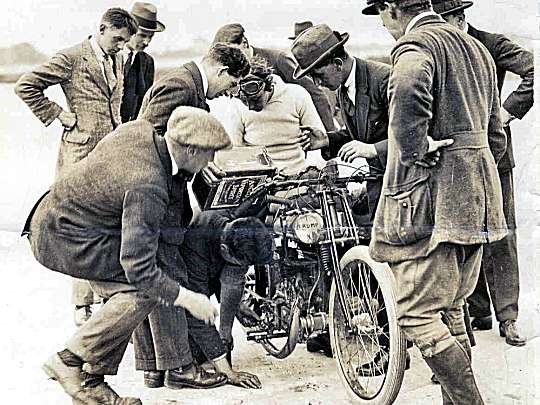
Gwenda Janson receiving attention to her Trump with JAP engine machine. This photo was possibly taken at the record attempt in July 1922 for the 'Double 12'.
Since Brooklands enforced a ban on noise at night, Gwenda was forced to seek out other tracks in order to fuel her love of racing, ending up at Montlhery in France, which at the time was an unrestricted circuit.
Her constant travelling resulted in the deterioration of her relationship with her husband Sam Janson, ultimately resulting in their divorce. Gwenda though quickly rebounded and promptly married Lieutenant Colonel Neil Stewart, the Managing Director of the Trump Motorcycle Company, a man whom she had met on her adventures.
She loved France and together they moved there and operated from premises under the banking at the newly opened Montlhery track just outside Paris.
Her string of successes continued unabated. At Montlhery, she co-rode a 350cc Rudge bike for an incredibly successful 24-hour record run, setting an average speed of 54.21 mph. This was achieved despite several excursions off the track, but even these didn't unsettle her. At the end of the 24 hour period they had broken 21 long-distance motorcycle records and all marks in their class.
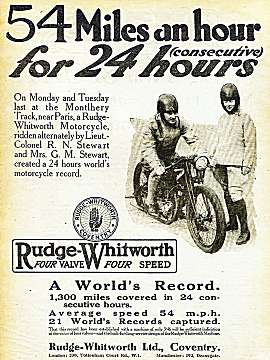
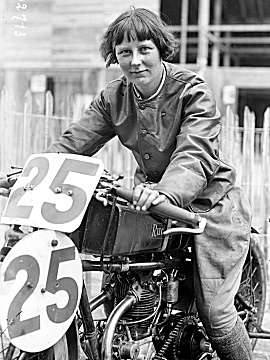
1925 - (left): extract from Motor Cycling of April 8, 1925 detailing the 24 hour world record.
(right): Gwenda Stewart on her Rudge at the Montlhery track
She and her husband moved into one of the rooms at the speed track so that they could take advantage of every possible moment of beautiful weather to try to set a new record.
However unsurprisingly, and perhaps because of the stress of living a life on the edge or perhaps simply due to Gwenda's flirtatious nature, the marriage didn't last.
Douglas Hawkes, a British motor car designer and fellow racer, had been engaged as her mechanic and his impeccable attention to detail setting up her bike appealed to Gwenda's military background, and the two soon found themselves falling in love.
She divorced Col. Stewart, married Hawkes, and at the age of 42 was moving on to the cars that her third husband adored as director of the Derby engine and car company.
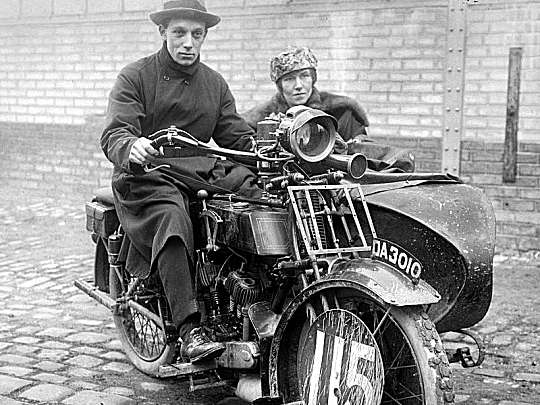
Douglas Hawkes, seen here riding a 750 AJS combo (with Gwenda in the sidecar) at the Paris-Nice race, was Gwenda's third and last husband. Born in Barton, Gloucestershire, he was a British motor car designer, businessman and racing driver
He prepared a very special single-seater Morgan for her and the following year she used it to take the world one-hour record at Montlhery. She also drove it at the mile and flying kilometer records at Arpajon in 1931.
The 'boat tail' Morgan three-wheeler used both the 761cc and 1100cc engines in record breaking attempts. She held close to 50 records in class J, (three-wheel cyclecars with passenger not exceeding 750cc), and also in class K, (three-wheel cyclecars not exceeding 1100cc).
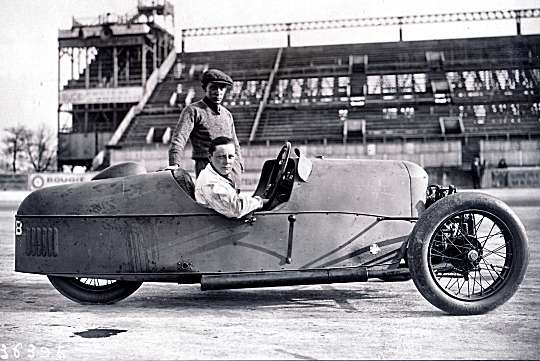
Gwenda Stewart racing her Morgan Three Wheeler at Montlhery in 1930
By now Gwenda was also a prolific record breaker in cars. She much preferred record breaking to road racing, feeling that she could compete on a more equal footing in this area of motor sport.
Banked tracks seemed to be Gwenda's specialty, and strangely when away from them she didn't have much luck. She entered Derby sports cars at Le Mans in both 1934 and 1935 but she failed to finish in either.
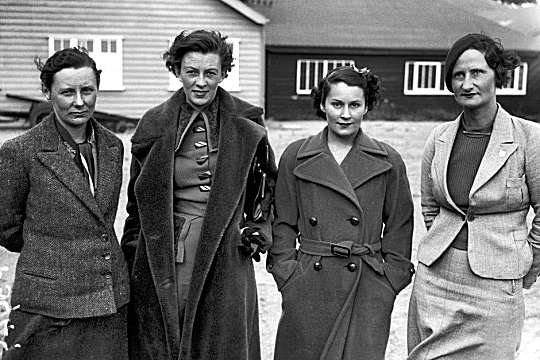
1935 - The elite of British women racing drivers at the time (from left to right): Gwenda Stewart, Doreen Evans, Kay Petre, and Elsie Wisdom
With World War II on the horizon, Gwenda and Douglas returned to England where Gwenda found a job in an armaments factory, working on a lathe and making shells for the war effort.
After the war the couple decided to end their racing career and moved to the Greek island of Poros. The two lived a comfortable life there, finding their excitement in travelling and boating rather than racing. Gwenda passed away there peacefully in 1990, just short of her 96th birthday.
Gwenda Hawkes serves as an incredible reminder that while the restrictions on women back then were pretty tough, they could still manage to find ways round the obstacles of the period and demand respect in their own right.
Aloha Wanderwell - the female Indiana Jones
The life story of Aloha Wanderwell, (Idris Galcia Hall nee Welsh, 13 October 1906 - 4 June 1996) is widely documented and there are many websites devoted to her life of intrigue and adventure. Suffice it to say that I'll paint a brief portrait that tells you a little of her accomplishments.
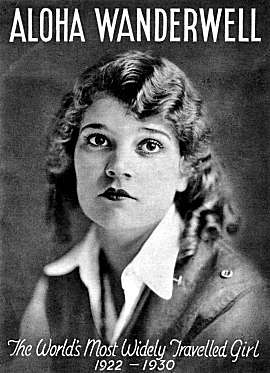
Although her adventures on a motorcycle figure less than her time behind the wheel of a car during her five year round-the-world journey between 1922 and 1927, they cannot be neglected. While it is true that Aloha Wanderwell was first and foremost an adventurer and explorer rather than purely a motorcyclist, she nevertheless deserves to be in this series, alongside her female counterparts of the time.
In the 1920s, while still a teenager, she became the first woman to circumnavigate the globe mainly in a 1918 Model T Ford. Remarkably she also achieved the same feat on an Indian motorcycle, an expedition initiated by 'Captain' Walter Wanderwell, a controversial figure of the time. He was jailed in the United States during World War I on suspicion of being a German spy, but released in 1918.
Born Idris Hall in 1906, Aloha was a 16-year-old convent student when she applied for a position on an expedition, led by Captain Walter Wanderwell, to circle the globe by car. For a girl growing up in British Columbia who dreamed of adventure, it was the chance of a lifetime.

Aloha and Walter Wanderwell
'Captain' Walter Wanderwell himself was a product of self-reinvention. Born Valerian Johannes Piecynski in Thorn, Poland, he adopted a new name and a strange military uniform when he disembarked from a steamship in Baltimore and began a walking tour of the United States. His tours and lectures evolved into motorcades intended to bring a message of unity to every nation on earth, starting with a trip from Mexico to Alaska.
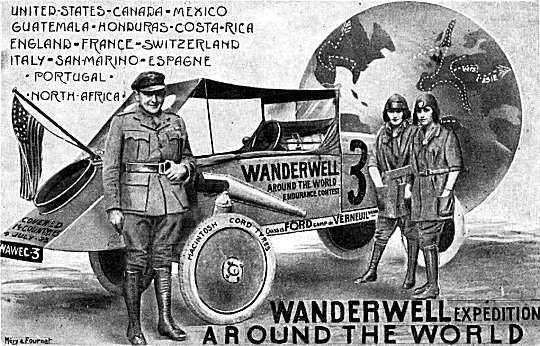
Postcard of the time. Like musicians today, the Wanderwell had a 'merchandising' table where they sold postcards
It was in Paris in 1922 that Wanderwell met Idris Hall, who would soon adopt the name 'Aloha.' Fluent in several languages, she persuaded Wanderwell to add her and a chaperone to the expedition. Six feet tall and with striking features, Aloha became the centre of attention wherever they went.
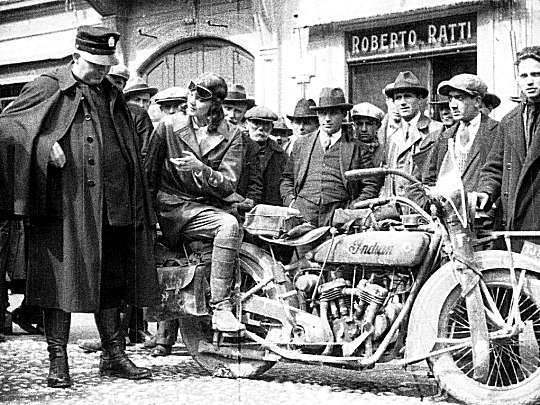
Aloha became the centre of attention wherever they went.
Walter Wanderwell's trip was part of a 'Million Dollar Wager', effectively a race between Ford sponsored teams driving Model Ts around the world, with the winner being the team visiting the most countries. Wanderwell's expedition was partly subsidised by lectures and film presentations along the route. Leaving from Nice in France, they travelled through Africa, the Middle East, Asia, and North America.
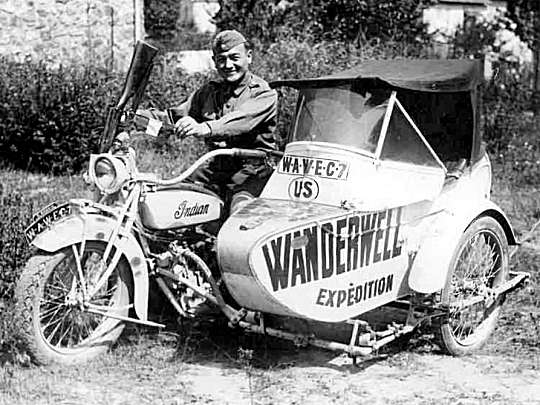
Walter Wanderwell posing here with the Indian, temporarily attached to a sidecar to take care of the transportation of expedition members from Berlin through Switzerland to Calais
Not long into Idris' journey, she took the stage name Aloha Wanderwell, even though Walter was married at the time. He subsequently divorced his wife although he didn't marry Aloha until 1925. The marriage eventually took place in Riverside, California, partly because the FBI was planning to arrest him for violating the Mann Act, which prohibited the crossing of state lines with a woman for 'immoral purposes'.
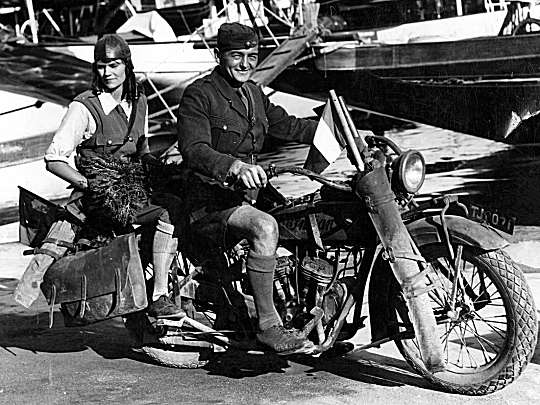
By 1929 they'd travelled 380,000 miles and visited 43 countries in four continents
Travelling overland in the 1920s was extremely difficult, and it's no wonder the expedition took four-and-a-half years to return to its starting point in Nice. Roads were poor or non-existent in many places, often there were no maps, and fuel stations were rare. Moving across Africa, they were forced to use crushed bananas for grease, and elephant fat in the crankcase.
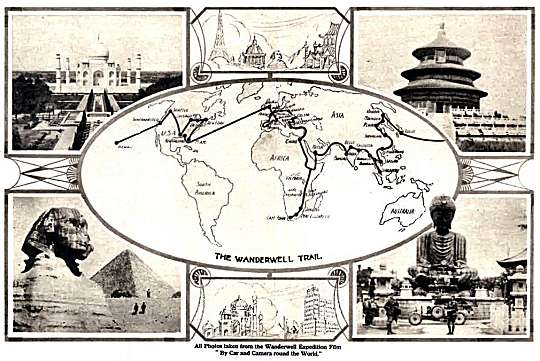
The Wanderwells route around the world
Although Aloha began as a secretary and assistant, she quickly became both the star and director of the films taken throughout the expedition. She served as a cinematographer, photographer, translator, driver, actress, and seamstress, and she filmed and wrote detailed descriptions of parts of the world that hadn't as yet been documented.
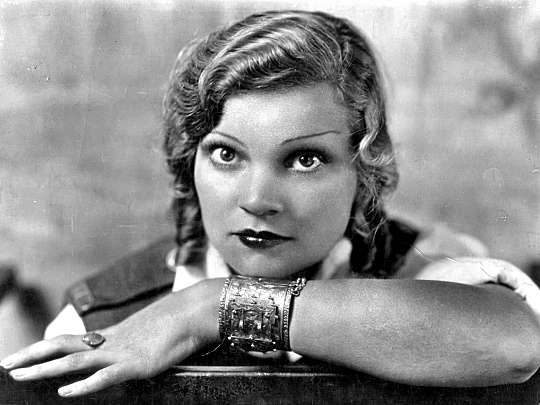
By the time the expedition had reached California in January 1925, Aloha was a star with incredible natural beauty as shown in this portrait. She met with Hollywood royalty Mary Pickford and Douglas Fairbanks while Pickford was filming 'Little Annie Rooney'.
When the initial expedition was finished, the Indian motorcycle apparently supplied by Indian themselves, (as mentioned in a letter to the Indian Motorcycle Co. in Jan.1931), was displayed on a red carpet in the Indian factory lobby, along with posters, letters, and photographs of the journey.
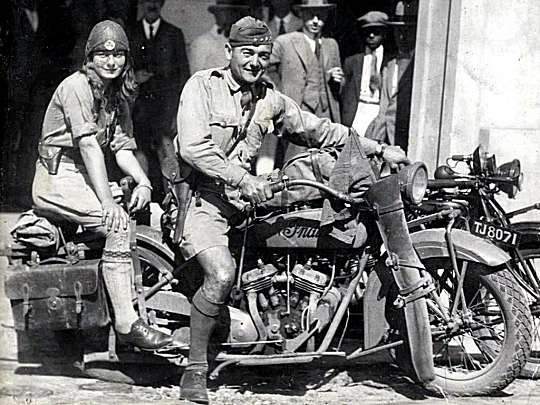
The Wanderwells photographed here in South Africa
The couple continued their travels even after having two children, visiting Cuba and South Africa.
As the 1920s came to a close, Wanderwell announced several additional expeditions. Aloha accompanied him on a trip to the Amazon, where they filmed indigenous tribes along with jungle scenery. However, 'Captain' Walter's adventures were cut short in 1932 when he was mysteriously murdered by an unknown assailant aboard the couple's yacht.
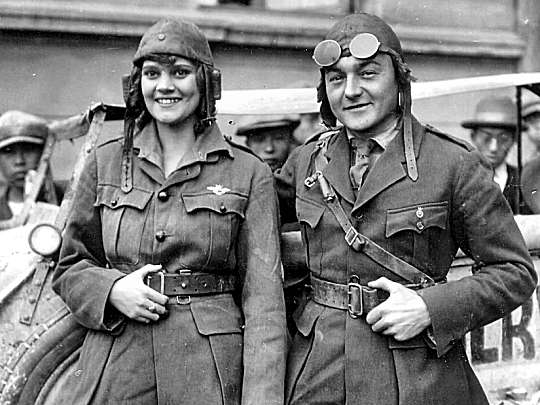
Wanderwell sold slots on his yacht docked at Long Beach for an around-the-world trip. Only days away from embarking, he was shot in the back and killed. The crime was never solved.
Wanderwell left an estate valued at $1,500; not much for a mother of two. Aloha had no choice but to continue writing and lecturing and a year after Wanderwell's murder in December 1933 she remarried a certain Walter Baker. By this point she was an accomplished filmmaker. But politics in the run-up to World War II created a serious impediment to filming and in 1939, she found herself working in radio and print journalism.
Her cinematographic work is scattered among several noteworthy institutions such as the Academy Film Archive, the Natural History Museum of Los Angeles and the Smithsonian Institution. Although her work can only be fully appreciated on a large cinema screen, some of her films are available on YouTube.
One such is this restored trailer titled 'With Car and Camera Round the World'. It's a silent film recounting their early adventures, and at each presentation Aloha herself narrated the film while it was being screened. They also cut and re-cut their footage to suit individual audiences:
If you enjoyed the story of the 'female Indiana Jones' who explored places where no other westerner had ventured, I recommend the video below:
An excellent pictorial biography which perfectly complements my story of this great lady who, almost 100 years ago, realised her adolescent dreams of travel, adventure, and intrigue in far-flung corners of the globe.
- Jean-Francois Helias